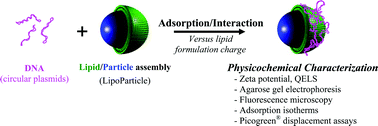Adsorption of plasmidDNA onto lipid/polymer particle assemblies
Abstract
In this study, the adsorption of

* Corresponding authors
a Laboratoire des Matériaux Inorganiques, UMR CNRS 6002, Université Blaise Pascal, 24 avenue des Landais, 63177 Aubière Cedex, France
b Laboratoire de Chimie des Polymères Organiques, UMR CNRS 5629, ENSCPB, 16 avenue Pey Berland, 33607 Pessac Cedex, France
c
Laboratoire des Matériaux Polymères et des Biomatériaux - IMP, UMR CNRS 5223, Université de Lyon 1, 15 Bd André Latarjet, 69622 Villeurbanne Cedex, France
E-mail:
catherine.ladaviere@univ-lyon1.fr
In this study, the adsorption of

 Please wait while we load your content...
Something went wrong. Try again?
Please wait while we load your content...
Something went wrong. Try again?
A. Troutier-Thuilliez, J. Thevenot, T. Delair and C. Ladavière, Soft Matter, 2009, 5, 4739 DOI: 10.1039/B911260J
To request permission to reproduce material from this article, please go to the Copyright Clearance Center request page.
If you are an author contributing to an RSC publication, you do not need to request permission provided correct acknowledgement is given.
If you are the author of this article, you do not need to request permission to reproduce figures and diagrams provided correct acknowledgement is given. If you want to reproduce the whole article in a third-party publication (excluding your thesis/dissertation for which permission is not required) please go to the Copyright Clearance Center request page.
Read more about how to correctly acknowledge RSC content.
 Fetching data from CrossRef.
Fetching data from CrossRef.
This may take some time to load.
Loading related content
